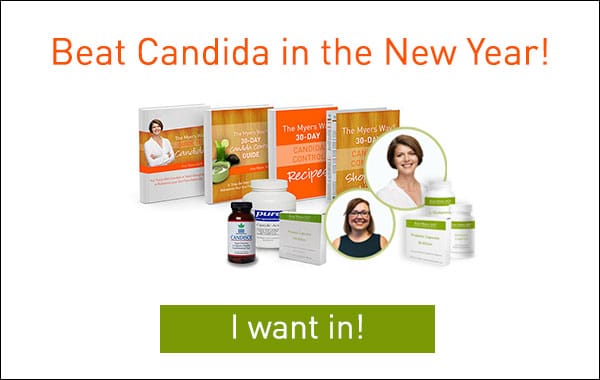As you probably know by now, Candida or yeast overgrowth is an incredibly common gut infection among those with autoimmune disease, Hashimoto’s, Graves’, thyroid dysfunction, gut issues, fatigue, brain fog, and other chronic health problems, and is particularly common after the stress and overindulgences of the holiday season.
It occurs when Candida, a form of fungus that lives in your digestive tract, colonizes your gut, overpowering the good bacteria that usually keep it in check. This wreaks havoc on your gut, causing it to become leaky and leading to a huge variety of symptoms, including digestive issues, fatigue, brain fog, recurring fungal infections, skin problems, seasonal allergies, and mood swings.
Many factors, including medications like antibiotics and birth control, and toxins contribute to Candida, but diet is often the biggest factor. A diet full of inflammatory, sugary, and processed foods creates the perfect conditions for yeast to thrive and multiply. That’s why eliminating the foods that feed Candida, and replacing them with whole, nutrient-dense foods, is a key step in beating Candida and healing your gut.
Whether you have an active Candida overgrowth, you’ve recently overcome Candida overgrowth, or you’re trying to prevent it in 2023, here are nine important foods to ditch.
Foods that Feed Candida
1. Sugar and Sweeteners
This one is a bit of a no brainer, but yeast feeds on sugar so you will want to cut out all sugar and sweeteners. The key here is avoiding not just the obvious sources such as sodas, candy, cakes, and cookies, but also the sugar lurking in unexpected places, such as salad dressings, low-fat packaged foods, protein bars, and more. Make sure to carefully check all of your food labels for hidden sources of sugar while following an anti-Candida diet.
2. Wine and Beer
Again, hopefully, you’re limiting alcohol already, but it is particularly important to cut out beer and wine while getting your yeast in check. Wine is not only fermented (meaning it is made from yeast), it is also high in sugar. And beer, which is also fermented, contains gluten. All of these factors contribute to Candida.
In addition, alcohol can worsen leaky gut, which is one of the most dangerous impacts of yeast overgrowth because it leads to so many other symptoms and health problems. It also suppresses your immune system, and a strong immune system is needed to keep your yeast population under control.
3. Dried Fruit and Fruit Juices
Although fruits can be part of an anti-inflammatory and antioxidant-rich diet, they are high in sugar and still feed Candida. If you find you have a problem with Candida overgrowth, try cutting out all dried fruit and fruit juice. You can still enjoy up to one cup of delicious whole fruits per day.
4. Gluten and Grains
As you know, gluten is highly inflammatory. It’s also a grain, and all grains are broken down into simple sugars during the digestive process, which can feed Candida. That’s why I recommend avoiding them entirely (particularly if you have an autoimmune disease) or limiting your intake of them. I’ve included some specific tips on exactly how much to limit grains, legumes, and starchy vegetables below.
5. Beans and Other Legumes
Even though beans and legumes provide a great plant protein, they are still starchy and feed Candida. Legumes can also be inflammatory for many people because they contain agglutinins. Like grains, I recommend minimizing legumes or eliminating them altogether.
6. Starchy Vegetables
Like fruit, this is one that sneaks by many people. Certain vegetables like acorn squash, butternut squash, and spaghetti squash are good sources of carbohydrates, but once eaten, they are broken down into sugars that feed Candida. Instead, focus on eating plenty of leafy greens, and other tasty veggies like Brussels sprouts, broccoli, cauliflower, and asparagus.
While following an anti-Candida diet, I advise keeping your combined consumption of grains, legumes, and starchy vegetables to one cup per day.
7. Mushrooms
Mushrooms are members of the fungi family and they can cross-react with Candida, meaning your body and your immune system may confuse them with Candida. This can cause you to have an inflammatory reaction to mushrooms and can interfere with your treatment.
8. Fermented Foods
This is a hotly debated topic, but I believe that anyone with Candida Overgrowth should avoid fermented foods until their yeast population is back under control. Fermented foods can be great to restore good bacteria because they are essentially food for good bacteria. However, Candida also likes to feed off the fermented foods, and for that reason, I recommend killing Candida first and then using fermented foods to help restore the good bacteria.
9. Dairy
Dairy doesn’t directly feed Candida, but it is highly inflammatory for many people. Inflammation damages your gut lining, which is already leaky due to Candida. This allows the yeast to continue escaping into your bloodstream, along with toxins, microbes, and other particles.
Once all of these foreign particles enter your bloodstream, they trigger a fresh wave of inflammation as your immune system tries to neutralize the threats. But, until your leaky gut heals, the particles just keep on coming, and this constant level of inflammation can eventually lead to an autoimmune disease.
Foods That Fight Candida Overgrowth
Ditching the nine foods above will go a long way in starving the yeast so that your good bacteria can restore your gut’s healthy balance. You can also stock up on foods that fight Candida overgrowth to help your body fight off the yeast overgrowth.
Some of the top foods that can help fight Candida growth include:
- coconut oil
- garlic
- apple cider vinegar
- cruciferous vegetables
- ginger
- olive oil
- cloves
- cinnamon
- wild salmon
- lemon juice
Supplements to Kill Candida
While adopting a low-carb and anti-inflammatory diet is key to beating your Candida overgrowth, using diet alone can take up to six months to restore your gut’s natural balance. That’s why I recommend adding in yeast-fighting supplements while following an anti-Candida diet.
The supplements I use in my clinic are caprylic acid and Candifense. Caprylic acid is a naturally occurring fatty acid that comes from coconut oil. Caprylic acid is known for its antiviral and antifungal activity. Candisol also contains a combination of plant-based enzymes that break down the cell walls of Candida.
I also recommend taking a high-quality probiotic to restore your population of good bacteria. These friendly bacteria strains will prevent a future Candida problem and are essential for supporting a healthy gut and immune system.
Are You Ready to Beat Your Candida in 2023?
Do you want to make 2023 your best year yet? Are you ready to heal your gut, beat symptoms for good, and look and feel great? If so, my January Candida Control Challenge is perfect for you!
You’ll get access to the exact Candida-fighting protocol that I use in my clinic, with all of the supplements, meal plans, and shopping lists for the full 30 days, plus 4 LIVE GROUP COACHING CALLS WITH ME!
Sign up now and rest easy over the holidays, knowing you have a plan for 2023!
The challenge begins January 15th and signup closes January 6th, so don’t wait – sign up today!

